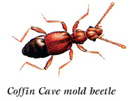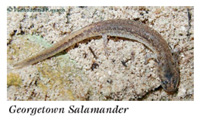Williamson County is home to five species that are listed as endangered.
Three of the endangered species are karst invertebrates that live in karst areas. A karst is the name for the honeycomb type limestone formations (including caves, sinkholes and fissures) that are typical in limestone geology.

- The Bone Cave harvestman (Texella reyesi) is found primarily in Williamson County.
- The Tooth Cave Ground Beetle (Rhadine persephone) is a tiny, reddish-brown beetle that spends its entire life underground.
- The Coffin Cave mold beetle (Batrisodes texanus) is a small, long-legged beetle that lives in total darkness and has no eyes. This beetle is found only in Williamson County.
Karst Invertebrates Brochure
Two endangered birds also nest in Williamson County.
- The golden-cheeked warbler (Dendroica chrysoparia) is a migratory songbird that builds nests of Ashe juniper bark (commonly referred to as cedar) in areas with mixed hardwoods. They winter in Central America but nest and breed only in Texas.
- The black-capped vireo (Vireo atricapillus) is another migratory songbird that builds its nests just a few feet from the ground in brushy, transitional habitat. PLEASE NOTE: The BCVI has been noticed for delisting by the US FIsh and Wildlife Service. Final determination of this delisting is expected by December 2017.
 The Georgetown Salamander (Eurycea naufragia), along with the Jollyville Plateau salamander (Eurycea tonkawae) and the Salado salamander (Eurycea chisholmensis) were all listed as threatened by the US FIsh and Wildlife Service in 2015.For additional information about the US Fish and Wildlife listing and the listing process go to https://www.fws.gov/southwest/es/AustinTexas/ESA_Sp_Salamanders.html.
The Georgetown Salamander (Eurycea naufragia), along with the Jollyville Plateau salamander (Eurycea tonkawae) and the Salado salamander (Eurycea chisholmensis) were all listed as threatened by the US FIsh and Wildlife Service in 2015.For additional information about the US Fish and Wildlife listing and the listing process go to https://www.fws.gov/southwest/es/AustinTexas/ESA_Sp_Salamanders.html.
To view a map of approximate locations of these species, click here. To view a map of Williamson County watersheds, click here.